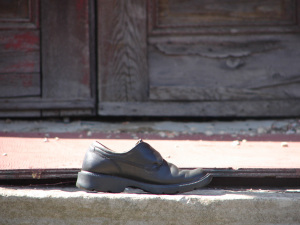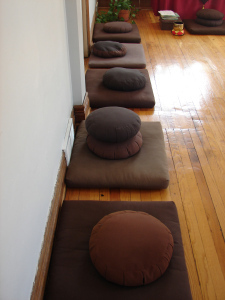Michael Kitchen's Blog, page 31
June 8, 2013
PUBLICATION ANNOUNCEMENT
I have just received an email from Grey Wolfe Publishing:
Dear Mike,
We are pleased to inform you that your story, “Mother Nature Makes The Extra Point” has been selected for inclusion in the Grey Wolfe Publishing summer edition of our quarterly literary journal, “Legends”.
According to the email, the “Summer Legends will be released and available for purchase on Amazon and for the Kindle by August 31, 2013. Please watch our website and Facebook page for the official release announcement.”
Stay tuned!


June 5, 2013
A Legend Overlooked Again.
I was browsing a local book store recently and a title on the New Arrivals table caught my eye. It was one of the local history books published by Arcadia Publishing, titled Legendary Locals of Detroit by Paul Vachon. The cover is adorned with fifteen black & white portrait photographs of some of the locals revealed within. I settled down in the cafe area with a brownie and pop, and flipped through the book. By the time I reached the end, I was once again disappointed.
This is a rant. I’m not singling out this book, it just seems to have pushed me over the tipping point.
Let me preface by saying that I am biased in my opinion on this. I co-wrote Down Through the Years: The Memoirs of Detroit City Council President Emeritus Erma Henderson with her. And when I began working on the project in 1999, up through today, I can’t find the words to express my feelings about the lack of inclusion of Erma Henderson in books covering recent history of Detroit. When I saw Legendary Locals of Detroit, I was certain I’d find Erma mentioned within.
Chapter One is titled “Firsts” which covers pioneers who “were unsung heroes who advanced the causes of civil rights, often at risk to their own safety.” Included in this chapter is Mary Beck – the first woman elected to Detroit’s Common Council (City Council) – and Jennifer Granholm – Michigan’s first woman governor who was born in Canada, and has no connection to Detroit.
Not Erma.
Chapter Two is titled “In The Public Square.” Included in this chapter are Detroit City Council members Maryann Mahaffey and Mel Ravitz, along with mayors, judges, governors and other social justice leaders.
Not Erma.
The rest of the book depicts people in the fields of business, sports and art, with a final chapter on “Demagogues. Disrupters, and Dissidents” which includes gangsters and racists.
How is it that Erma Henderson is always overlooked in Detroit history books?
Erma Henderson was not the first woman on City Council, but she was the first African American – male or female – to be elected President of the Detroit City Council, by accumulating the most votes on election day. And she held the presidency for four straight terms! The election she won in 1972 to get on the Detroit City Council was in a head-to-head contest against Jack Kelly, an influential and popular white male. Kelly was elected to City Council the following year, 1973, along with Erma, when the entire council was up for election.
On Council, Erma took on the insurance and mortgage companies and banks, leading an anti-red lining campaign that challenged Michigan’s laws that allowed the practice of denying insurance and loans or charging exorbitant rates, to credit-worthy individuals and businesses simply because they were located in a particular area red-lined by financial institutions. Her crusade caused the Michigan legislature to enact the most comprehensive Anti-Redlining laws in the nation at that time. A woman thirty years ahead of the Occupy movement.
She fought for civil rights as early as her high school days, where she demanded that the high school senior class photo no longer place all the black graduates at the bottom of the photo – where they could be clipped off. The school changed the senior class photo and placed the students in alphabetical order. In 1938 she led a sit-in at the Pantland Hotel in downtown Grand Rapids where she was attending the Michigan Republican Convention as a delegate, but was denied a room at the hotel because the hotel refused to allow minorities accommodations.
She was named the Executive Director of the Equal Justice Council following the 1967 disturbance where she coordinated the monitoring of the courts and compiled data on judges, attorneys and defendants. The court watchers documented evidence of indifference towards poor and minority defendants. The data was analyzed and published by the University of Michigan School of Social Work, which was a major factor in (1) the elimination of some visiting judges, (2) permanent funding for full-time jail ministry, (3) and several new judgeship appointments to Detroit’s criminal courts. It was nationally recognized as being the most effective court-watch program in the nation in 1974.
She founded the Women’s Conference of Concerns which became a major coalition-building base of power for women’s organizations in Southeast Michigan.
Among the gallery of awards that she was honored with includes:
The Detroit News’ “Michiganian of the Year”
Michigan Education Association’s “Distinguished Service Award.”
Salvation Army’s “Citizen of the Year Award”
National Organization of Women’s “Feminist of the Year Award”
Detroit Free Press “10 Most Influential Women in Detroit”
Michigan Women’s Foundation’s Trillium Award (Lifetime Achievement).
She has both a school and a park named in honor of her – both during her lifetime. Detroit City Council meets in the
And I’m just scratching the surface.
Yet, Erma Henderson is not a legendary local. Why not?
Her entire life was dedicated being a champion for the people of Detroit.
Detroit history writers – quit overlooking Erma Henderson.
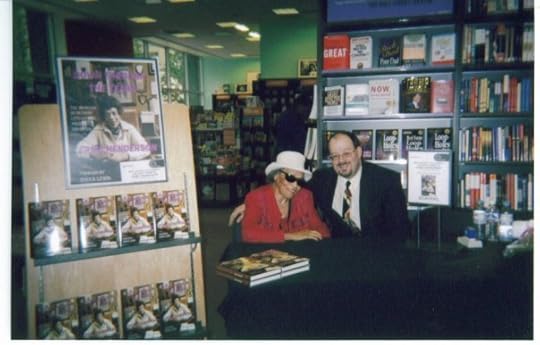
Erma Henderson & I at her book signing at Borders in Detroit. Photo by Denise Kitchen


May 29, 2013
It’s not about the money.
I was thumbing through an old journal when I came across this interesting entry.
While I still was running Waking Up in December, 2006, a friend of mine suggested that I seek out paid writing work. I had an abundance of time in the store when no customers were around. I mentioned that I had begun working on a project. He asked if it was a paying project and I said no, that it was the novel I’ve always wanted to write. He quoted someone as saying that every person has a great novel within them, but in most cases, it should stay within them.
I’m glad I didn’t take that advice.
And you shouldn’t take it, either.
Being compensated financially for one’s writing is something that is merited. If a writer puts in the effort, she should be compensated by her readers who partake in the enjoyment of her work. However, to me, that is secondary. Writing to get paid is capitalist rhetoric. Getting paid for one’s writing is freedom.
For the disadvantages and dangers of the author’s calling are offset by an advantage so great as to make all its difficulties, disappointments, and maybe hardships, unimportant. It gives him spiritual freedom. To him life is a tragedy and by his gift of creation he enjoys the catharsis, the purging of pity and terror, which Aristotle tells us it the object of art. For his sins and his follies, the unhappiness that befalls him, his unrequited love, his physical defects, illness, privation, his hopes abandoned, his griefs, humiliations, everything is transformed by his power into material, and by writing it he can overcome it. Everything is grist to his mill, from the glimpse of a face in the street to a war that convulses the civilized world, from the scent of a rose to the death of a friend. Nothing befalls him that he cannot transmute into a stanza, a song, or a story, and having done this be rid of it. The artist is the only free man.
W. Somerset Maugham The Summing Up

Photograph by Michael Kitchen


May 24, 2013
Declaring my Independence
I met my hero, William Kent Krueger, on Monday. Maybe hero isn’t the right word. His work hasn’t influenced me, mainly because I haven’t read his writing. But he’s lived the writing dream that I seek.
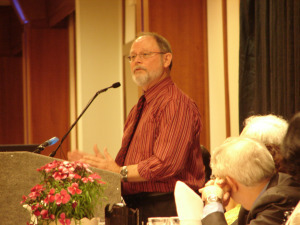
William Kent Krueger at Metro Detroit Book and Author Society luncheon, 5-20-2013. Photo by Michael Kitchen.
Krueger has published 14 novels, many of which feature Cork O’Connor, his mystery series character. His current novel, Ordinary Grace (Atria Books, 2013) made the Indie Next List in April, 2013. And he was a speaker at the Metro Detroit Book and Author Society luncheon on Monday, May 20, 2013.
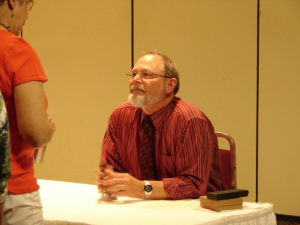
William Kent Krueger at Metro Detroit Book and Author Society luncheon, 5-20-2013. Photo by Michael Kitchen.
He is living my writing dream.
After the event, I purchased Ordinary Grace and approached him with the question of how he started – by submitting to agents or publishers first? He explained he went through an agent and was able to get his first book sold. He also talked about how self-publishing “back in the day” (he’s about the same age, maybe a handful of years older than I) was taboo, however that has changed immensely. I mentioned that self-published books didn’t get into the book stores, and he said that things are opening up, that as the author, I have more control, and that self-publishing is something to consider.
Huh.
I’ve been attending a number of author events – writer’s conferences, book signings, luncheons, National Writers Series lectures – to bring me up-to-date on how today’s authors are making it in to traditional publishing. I’ve learned that there seems to be two ways.
1. Many of the writers have either a) pursued a Masters in Fine Arts, and by doing so have made connections through the programs they’re in, or b) have made similar connections by working in the field of media entertainment.
Or
2. As Brad Thor, who also spoke at the Metro Detroit Book & Author Society luncheon, did. He and his wife were spending their honeymoon in Europe and shared a train car with a brother and sister from Atlanta, Georgia. The woman happened to be a sales rep with Simon & Shuster, and he submitted his first manuscript to her. He has since published twelve novels at Simon & Shuster.

Brad Thor at Metro Detroit Book and Author Society luncheon, 5-20-2013. Photo by Michael Kitchen.
These are not the circles I travel in. I’m still paying off law school student loan debt, so pursuing another degree is not in consideration. But like in my law practice, I am continuing my writing education by taking seminars, engaging in writer’s groups and studying the craft. And unless an employee of a major publisher is appointed to me by the Macomb County Circuit Court, it is unlikely I’ll ever fall into a situation where a Brad Thorish personal connection could ever take place.
How long will I continue pursuing that which seems as likely as hitting the lotto? It’s time to give self-publishing serious consideration.
I have experience at it, through writing and publishing Erma Henderson’s memoirs. And better, I know a publisher whose business platform is not just to take your money and publish your manuscript (no matter what the quality) and send you on your way. This publisher will not accept a manuscript that is poorly written, and provides copy editing as a part of its service. It is also focused on getting its books on the shelves of book stores, not just the ability to order the book. And the editor has a sincere passion for encouraging and helping writers hone their craft and for book publishing.
I was concerned about publicity, as the commercial publications tend not to review self-published books, and tend not to include them on best-seller lists. The Indie-Next List that promotes books in independent book stores, covers only books that are traditionally published. But, I’ve discovered that Shelf Awareness – a source of news for book sellers – includes a best sellers list of self-published books (provided by IndieReader). The chance to be reviewed in a magazine available in the chain book stores – ForeWords Reviews – also exists (which is published Traverse City – my home away from home). And I’m probably just scratching the surface of the world of independent and self-publishing.
And, I have William Kent Krueger, living my dream, encouraging a new author like me to seriously consider self-publishing. Why? Maybe my dream has a dark side?
There are still a number of agent queries out there for The Y in Life. I’ll give them the opportunity to respond. But after the date I have in mind, the novel goes the self-published route and will likely be available before the end of the year. And the NaNoWriMo novel I wrote in November which is in rough form, I have begun rewriting for definite publication through my independent publisher.
Seriously, when have I ever been “traditional?”


April 12, 2013
Opening Day in Detroit – Celebration of baseball or excuse for drunk and disorderliness away from home?
Thursday is bowling night for me. Last night, I arrived early as I normally do. The television screens hanging between the computer screens showing our bowlers and scores were tuned in to the Detroit Tigers baseball game. It was a rebroadcast of the game played earlier in the day, where the Tigers hosted the Blue Jays and won 11-1. Taking glancing views of it something caught my eye.
Where were all the people?
The lower level stands were sparsely populated, and though the box score indicated almost 29,000 in attendance, that seemed highly unlikely. 2,900 would have been a more believable number to the naked eye.
But then I remembered that a week ago, 45,051 packed the Tigers’ home stadium for Opening Day.
I acknowledge that I am a sports fan. I’ll block out time to go to a Detroit City FC match or drive to Columbus, Ohio for an MLS Columbus Crew game. I belonged to team booster clubs, and felt that places like The Palace in Auburn Hills, Crew Stadium, Highbury and the Montreal Forum were holy grounds.
But Opening Day in Detroit reminds me that the best part of sports is the fans…and the worst part of sports is the fans.
The best of sports fandom for Tigers’ Opening Day were the 45,000 fans that purchased tickets and viewed the game rooting on their team as well as the fans who watched the game from their homes, from local taverns or even from bars in Detroit. They have a passion and care for the game and the results, and the team. The Tiger’s home stadium is a hallowed ground to them.
The worst part of sports fandom for Tigers’ Opening Day were those “fans” that use it as an excuse to party and trash the City of Detroit. Littered streets, jaywalking drunks, and use of the sidewalks and building walls as public urinals leaves the City and its residents to clean up this boozy landfill. They even destroy historic homes.
When I brought this issue up on my Facebook page, an ex-friend (he “unfriended” me at the conclusion of our conversation), argued that the problems were the result of a minority of people, that it happens everywhere like U of M and Detroit Lions games, and that yes, people should be more discrete in their urinating. I wanted clarity as to what he meant by being more discrete. The use of public rest rooms, right? No. This white suburban law enforcement officer said that most of the parties do not have adequate restroom options and that people should “relieve themselves” discretely.
In other words, public urination by those who go to Detroit to party during Opening Day – not even taking in the game, but going from party to party and getting drunk – was appropriate if done discretely. I didn’t get a chance to ask him if a homeless person – on a day other than Opening Day – could also be allowed to discretely urinate in public, or would this law enforcement officer arrest the homeless person on a criminal charge that would put him or her on the sex offender registry. Nor did I inquire whether he was experienced and could explain exactly how to discretely urinate in public. I was too shocked and disgusted by his sense of privilege and entitlement and he had unfriended me by then.
I mention “privilege” because the unfortunate fact is the demographics of our area is deeply segregated. Using US Census Data, the residents of the City of Detroit are 82.7% African American. Detroit is within Wayne County, and the White residential population within Wayne County, not including Detroit, is roughly 87.3%; Macomb County is 85.2% White, and Oakland County is 77.7% White.
Phreddy Wischusen wrote an op-ed that was published the day before Opening Day in the Michigan Chronicle, detailing experiences he’s had on previous Opening Days.
Wischusen is not some radical African American Detroit resident. He is a middle class white man whose trust fund paid for his college. He details exposure to racism by white people who express their racist thoughts with him because they feel he, being white, is in agreement with them. I can relate, as I have had that experience all too often myself – not specifically on Opening Day because I am not a baseball fan – but in other settings.
Again, I’m a sports fan. I understand celebrating the opening of your favorite sports team’s season. I love enthusiastic sports fans, like the Northern Guard Supporters and Motor City Supporters at Detroit City FC matches. I admire the creative and absurd like Crazy Claude – the trumpeter – and those strange guys dressing up in full body spandex suits. And sitting amongst the Timbers Army in Portland is on my bucket list.
I absolutely do not get the people who go to a city where an event is happening solely as an excuse to party. These people are not Tigers fans or sports fans. And in the case of Detroit and Opening Day, they are a part of the problem.
I’ve never been a drinker, so I don’t understand the need to drink so much alcohol on Opening Day in Detroit you use Facebook as a means to find a ride home because you’re too drunk to drive; to cause destruction; and/or to “discretely” urinate in public, under the excuse of it being “Opening Day.”
Opening Day is for baseball and the fans who watch it and follow it. Like the few real fans who showed up and watched the non-Opening Day game against the Blue Jays.

Photo by Michael Kitchen


March 30, 2013
Buddhist Photo Walk (with haiku)
The following photos I took during a Buddhist Photo Walk, led by Bija Andrew Wright at Still Point Temple, Detroit, Michigan on March 30, 2013.
Sparrow singing-
it’s tiny mouth
open.
Buson (1716-1784)
Goes out,
comes back-
the loves of a cat.
Issa (1762-1826)
In the falling of the petals
they see no Buddha,
no law.
Issa (from The Six Ways: Animals).
First day of spring-
I keep thinking about
the end of autumn.
Basho (1644-1694)
Coming back-
so many pathways
through the spring grass.
Buson (1715-1783)
Good house:
sparrows out back
feasting in the millet.
Basho (1644-1694)
This old village-
not a single house
without persimmon trees.
Basho (1644-1694)
Don’t worry, spiders,
I keep house
casually.
Issa (1762-1826)
This mind itself is Buddha;
Practice is difficult, expounding is easy.
No mind, no Buddha;
Expounding is difficult, practice is easy.
Dogen (1200-1253)


March 17, 2013
50th Anniversary of Gideon’s 6th Amendment Victory
You or your son or daughter are driving in your vehicle when a police officer pulls you over. You resign the fact that you were driving above the speed limit, but didn’t think it was a big deal. You notice the officer looking in the windows of your car as he approaches. The officer asks for your drivers license and proof of insurance and you give them to him. He again looks in your back seat window as he returns to his vehicle. When he returns, he instructs you to step out of the car and asks you if you have anything illegal on your possession that he should know about. You tell him that you don’t, to which he asks if you mind if he searches the car. You don’t have anything to hide and allow him. He finds a small plastic bag of marijuana in the back seat. You loaned the car to your son or daughter when they went out with friends the past weekend, and assume it belongs to one of their friends. But that doesn’t matter because you’re sitting in the back of the squad car, on your way to the police station to be booked and fingerprinted. You’re now facing a charge of possession of a controlled substance, which is punishable by four years in prison. You’re given an arraignment date. When you appear before the judge, you enter a not-guilty plea. Being financially strapped as you are between jobs or lost one of your part-time jobs, you ask the judge for your Sixth Amendment right to counsel. The judge declines and you’re forced to take your case to trial all on your own.
That’s what would have happened fifty years ago.
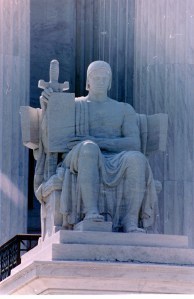
Photo by Mike Kitchen
The landmark case of Gideon vs Wainwright was decided by the United States Supreme Court on March 18, 1963. In 1961, Clarence Earl Gideon, father of six, was charged with breaking and entering with intent to commit a misdemeanor, which was a felony under Florida law. He asked the court to appoint counsel, which the Florida judge denied. The judge stated that “Under the laws of the State of Florida, the only time the Court can appoint Counsel to represent a Defendant is when that person is charged with a capital offense.” Gideon was forced to defend himself. He conducted his own trial and the jury returned with a guilty verdict. Sentenced to five years in prison, Gideon petitioned the Florida Supreme Court, appealing his conviction based on the lower court’s failure to provide him counsel arguing it was guaranteed under the United States Constitution and Bill of Rights. The Supreme Court of Florida denied relief.
Gideon didn’t stop there. He petitioned the United States Supreme Court, which granted him a hearing. The Court also appointed counsel to represent him. Oral arguments before the Court were held on January 15, 1963.
AMENDMENT 6
In all criminal prosecutions, the accused shall enjoy the right to a speedy and public trial, by an impartial jury of the State and district wherein the crime shall have been committed, which district shall have been previously ascertained by law, and to be informed of the nature and cause of the accusation; to be confronted with the witnesses against him; compulsory process for obtaining witnesses in his favor, and to have the Assistance of Counsel for his defense.
Before 1938, courts would appoint counsel for indigent defendants, however it was sporadic in execution. In Johnson v. Zerbst, the US Supreme Court held that the 6th Amendment right to counsel was valid in federal court unless the defendant waived the right. The 6th Amendment Rights – minus the right to counsel – was made obligatory on the States by the Fourteenth Amendment in the 1942 US Supreme Court decision of Betts v. Brady. In Betts, the court had concluded that because the defendant was a 43 year old man of ordinary intelligence and ability to take care of his own interests, he was not at a serious disadvantage at trial.
It took only two months for the Court to render its unanimous decision in favor of Gideon. The Court held that the Betts decision was wrong. Justice Hugo Black, writing for the Court, stated:
The right of one charged with crime to counsel may not be deemed fundamental and essential to fair trials in some countries, but it is in ours. From the very beginning, our state and national constitutions and laws have laid great emphasis on procedural and substantive safeguards designed to assure fair trials before impartial tribunals in which every defendant stands equal before the law. This noble ideal cannot be realized if the poor man charged with crime has to face his accusers without a lawyer to assist him.
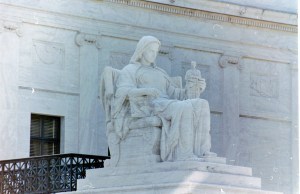
Photo by Mike Kitchen
Gideon’s case was referred back to the Florida court, where a new trial was held. The court appointed counsel and after only an hour of jury deliberation, Clarence Gideon was found not guilty. After losing two years of his life in prison, Clarence Gideon was released as an innocent man.
Justice Black wrote into the Gideon opinion that, “government hires lawyers to prosecute and defendants who have money hire lawyers to defend are the strongest indications of the wide-spread belief that lawyers in criminal courts are necessities, not luxuries.” That doesn’t mean that the states have a public defense budget equal to its prosecutorial budget. When it comes to per capita spending, according to a 2008 study, Michigan ranks 44th in per capita spending on indigent defense ($7.35 per capita), and is dispensed on a county by county basis, meaning an unbalanced approach to delivery and payment of public defense.
Fifty years ago, it would have been you (or your son or daughter) versus a well-funded, government prosecutor in your case of marijuana possession. Clarence Gideon’s two-year fight from his prison cell insures that if you cannot afford an attorney, one will be appointed for you.
SOURCES:
Books:
American Criminal Procedure: Cases and Commentary, Stephen A. Saltzburg & Daniel J. Capra (West Group, 6th Edition 2000)
May It Please The Court…Transcripts of 23 Live Recordings of Landmark Cases as Argued Before the Supreme Court, Edited by Peter Irons and Stephanie Guitton (The New Press, 1993)
Cases:
Gideon v. Wainwright, 372 U.S. 335 (1963)
Betts v. Brady, 316 U.S. 455 (1942)
Powell v. Alabama, 287 U.S. 45 (1932)
Johnson v. Zerbst, 304 U.S. 458 (1938)


March 10, 2013
Where do enemies come from?
Where do enemies come from?
The American Heritage Dictionary defines enemy as “one who feels hatred toward, intends injury to, or opposes the interests of another.”
In our personal life, an enemy can be obvious. In elementary school, a kid who conspired with two of my friends to steal baseball cards from me became someone I considered an enemy. In middle school, a kid who introduced me to comic book collecting made physical threats via telephone when in high school became someone I considered an enemy. I felt hatred towards those two people as a result of their actions towards me.
An enemy can expand into a broader group. For example, sports rivalries can create enemies. University of Michigan football fans hate Ohio State University and its football fans and visa-verse. The rivalry arises from opposing interests seeking the same goal that only one can achieve – a victory over the other on the field of play. As an Arsenal fan, I hate Manchester United. I’m also supposed to hate Tottenham Hotspur, because they are the main geographic rival to the Gunners; their stadiums just a few miles apart. But not having grown up in north London, the battle for the top of the league against Manchester United formed my hatred of the Red Devils and my ambivalence towards Tottenham.
Enemies emerge out of competing ideologies; religion and politics, for example. Others are based on cultural identities, like nationalities or regions within a country. There are some people in the southern states of the US that still despise “Yankees.”
These latter group enemies I believe are not genuinely made, but rather learned. When one identifies with a certain group, the person becomes indoctrinated into making an enemy of another group. Being a Michigan resident, and not having any ties or familial history with the University of Michigan, I don’t think twice about driving to Columbus, Ohio and calling the Columbus Crew my favorite Major League Soccer team. I had a conversation with a friend about soccer and going to Crew home games. He being a University of Michigan fan stated that he could never see himself rooting for a team from Columbus.
I pondered this question of where enemies come from as a result of the recent death of Venezuelan president Hugo Chavez. To listen to American media and elected officials, one might have been indoctrinated to believe the Venezuelan president was our enemy. I reject that notion.
United States media has portrayed Chavez as an enemy. Democratic strategist Doug Schoen on CNN in January, 2009, said of Chavez that “He’s given Al-Qaeda and Hamas an open invitation to come to Caracas.” Newsweek compared Chavez to Mussolini, Hitler and Stalin. ABC labeled him as a “fierce enemy of the United States.” The Washington Post declared Chavez an “autocratic demagogue.” And of course, Fox News said that Chavez’s government was “really communism.”
A closer examination reveals that Hugo Chavez was nothing close to what the US media painted him to be.
In 1998, Hugo Chavez won the election for President with 56% of the vote, and was inaugurated in 1999. Speaking out forcefully against globalization, he introduced a hydrocarbons law that doubled royalties charged to foreign oil companies and replaced Petroleos de Venezuela, the state-owned oil company’s top executives with people loyal to him. (Confessions of an Economic Hit Man, John Perkins, pg 196). Prior to his election, austerity measures imposed by the IMF in 1989, saw Venezuela’s per capita income plummet 40% between 1978 and 2003. (Perkins, page 197).
Chavez kept his commitments to the poor – urban and rural. Instead of re-injecting profits into the oil industry, he invested them in projects aimed at combating illiteracy, malnutrition, diseases, and other social ills. Rather than declaring huge dividends for investors, he helped Argentina’s embattled President Kirchner buy down that nation’s IMF debts of more than $10 billion and he sold discounted oil to those who could not afford to pay the going price – including communities in the United States. He earmarked a portion of his oil revenues for Cuba so it could send medical doctors to impoverished areas around the continent. He forged laws that consolidated the rights of indigenous people – including language and land ownership rights – and fought for the establishment of Afro-Venezuelan curricula in public schools. (The Secret History of the American Empire by John Perkins, pg 111).
During Chavez’ 14 year presidency, poverty fell from 55% in 1995 to 26.4% in 2009. Unemployment was 15% in 1999, which has fallen to 7.8% in June, 2009. “Over the last fourteen years, Chávez has submitted himself and his agenda to fourteen national votes, winning thirteen of them by large margins, in polling deemed by Jimmy Carter to be “best in the world” out of the ninety-two elections that he has monitored.” Over 30,000 communal councils, direct participatory democratic structures were formed over Chavez’s presidency, making the country more democratic than prior to Chavez’s first election victory in 1998. Cooperatives and self-managed workplaces also grew.
Perhaps you’ll recall Hugo Chavez’s speech on September 20, 2006 before the United Nations. Popularized in the news was his referral to George W. Bush as “the devil” who, having spoken there the day before, Chavez said he could smell sulfur. A New York Times reporter said that Chavez received “loud applause that lasted so long that the organization’s officials had to tell the cheering group to cut it out.” (Helene Cooper, “Iran Who? Venezuela Takes the Lead in a Battle of Anti-U.S. Sound Bites,” New York Times, 21 September 2006, cited in What We Say Goes by Noam Chomsky, pg 45). Did they cheer about Chavez’s name calling? The NY Times reporter did not address that question. “It was because he (Chavez) was expressing a point of view that happens to be very widely accepted in the world. In fact it’s the overwhelmingly dominant position. Chavez’s views are called “controversial.” It’s quite the opposite. It’s the views of the U.S media and commentators that are controversial.” (Chomsky, pg 45)
Where do enemies come from? There are those who harm you personally, the ones you know and can identify. But then there are others who try to convince you that “they” are your enemy, because you are one of “us.” The corporatocracy tried to sell to me that Hugo Chavez was an enemy. He was an enemy to their tyranny only. Not to the people of Venezuela or, for that matter, people around the world, including Americans.
Sources:
“Hugo Chavez Kept His Promise to the People of Venezuela” by Oscar Guardiola-Rivera http://www.commondreams.org/view/2013/03/05-8#.UTfKPckDdXs.facebook
“Chavez Democratized Venezuela Making it the Most Equal Country in Latin America” By Gregory Wilpert http://venezuelanalysis.com/video/8073
“In Death as in Life, Chavez Target of Media Scorn” by Fairness & Accuracy in Reporting. http://fair.org/take-action/media-advisories/in-death-as-in-life-chavez-target-of-media-scorn/
“The CIA Was Involved in the Coup Against Venezuela’s Chavez” by Eva Golinger http://venezuelanalysis.com/analysis/800
“On the Legacy of Hugo Chavez” by Greg Grandin http://www.commondreams.org/view/2013/03/06-2
“Hugo Chavez Dead: Transformed Venezuela & Survived U.S.-Backed Coup, Now Leaves Uncertainty Behind” – Democracy Now! http://www.democracynow.org/2013/3/6/hugo_chvez_dead_venezuelan_leader_leaves
Confessions of an Economic Hit Man by John Perkins (Berrett-Koehler Publishers, Inc. 2004).
The Secret History of the American Empire by John Perkins (Dutton, 2007)
What We Say Goes by Noam Chomsky (Metropolitan Books, 2007)


February 24, 2013
The comfortable were afflicted
Humorist Finley Peter Dunne once wrote about the powerful influence of newspapers; that, among other things, they comfort the afflicted and afflict the comfortable. “Mother” Mary Jones applied its usage to social activism, and others have applied it to religion.
My first introduction to the phrase came through my involvement in social activism as well, but I’ve felt that it was also a hallmark of good writing. Both fiction and nonfiction can deliver the punch of awareness to injustice and force us to face our fears and failings. Fiction has the power to make a reader reflect, reconsider, sympathize, understand, or even heal from one’s own situation. Fiction is even more powerful at changing our views than nonfiction, because when we read nonfiction, we guard our views. Reading fiction our guard drops as we become emotionally involved in the story.
I recently attended the book launch for an anthology in which three of my pieces were published. The event included readings by authors published within the book. The second writer introduced by the book’s publisher was Talyn Marie, who had two short stories included in the anthology.
Before Talyn began reading her story, “Norton,” she prefaced the piece as something that she wrote following the “write what you fear” advice writers receive. For example, Natalie Goldberg advises authors to “(w)rite what disturbs you, what you fear, what you have not been willing to speak about. Be willing to be split open.” Undertaking the new role of mother was the seed of the Talyn’s story. Becoming a parent is both exciting and also fraught with fears.
It was a soft warning. The story, “Norton” is about a child molester as he pursues his prey. Deliberate writing set the scene as Norton executed his plan. As the story progressed, it became clear what Norton was about and where it was going. And it got deeper. The suspense grew as Norton closed in on a particular child he targeted. My wife sitting next to me, reading along with Talyn, closed the book. I heard a guy behind me say that he didn’t have to listen to this and left. He wasn’t alone. Even the publisher moved from his sitting position at the front of the room to the side, nervously wondering what he unleashed.
I, on the other hand, was riveted. Not just to the story, but to the reaction. It wasn’t that I sympathized with Norton (he does confront and is defeated by his own demon in the end), but by the power of the story. Talyn afflicted fear upon the audience seated within the comfortable confines of a yacht club. It moved people…some of them right out of the room!
Whether this story should have been read is no fault of Talyn’s. The publisher clearly had no knowledge of the content of the book he published, and failed to plan and vet the readers for its launch. Though there were five other authors reading their fine work, everyone present will remember the blizzard we drove through to attend the event, and Talyn’s story.
Good writing provokes. Julian Barnes wrote that “(w)hen you read a great book (or story), you don’t escape from life, you plunge deeper into it. There may be a superficial escape…but what you are essentially doing is furthering your understanding of life’s subtleties, paradoxes, joys, pains, and truths.” Good writing can push us to think, to sympathize, to feel. It can take the reader to those uncomfortable places that are frightening to face, and places us before demons we refuse to admit exist.






